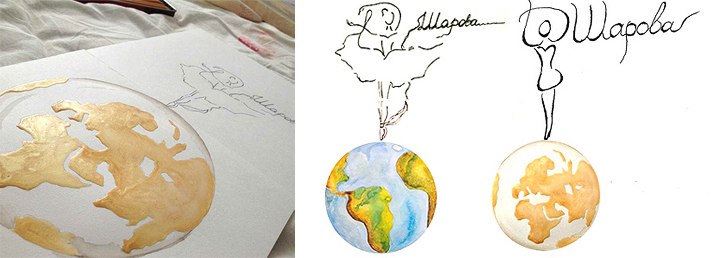War with the designer: where does good design come from
Have you ordered design more than 9000 times, and have you never been disappointed? Creative people understand you at a glance, and the result of their work certainly pleases your eye and wallet? Maybe you are a professional designer who has mastered the skill of communicating with a download to a master level?
Then this post is not for you. You already know everything.
But if the letters from the designer who deals with your project begin with the heading “edits ver_3_b_part II”, and it becomes more and more difficult to communicate every day - try to read. Maybe there is some useful advice here that will make your life easier and save money.
I offer to your attention a few notes-considerations that have accumulated during my work in this area.

')
- “What a deformity. Unforgivable, ugly, shameful. He has pain in his eyes, bitterness on his tongue and a heavy, aching heart. ” Designer Vasya closed Photoshop, swearing and cursing the customer. That beauty, which he lovingly outlined for three days, did not remain a trace. It remains only an ugly disgrace with funny, inconspicuous orange buttons. “No one will ever click on that,” he muttered.
Let's think about how it happened: we met a good designer and a completely miserable customer, started working. And everything seemed to be going well, but gradually both of them realized that they hated each other, and the design was terrible.
Often the reason for this is that the customer and the designer are initially different goals. The customer rightly wants his project to make a profit in the future, and - how can - tries to send the designer in the right direction. And what a designer? He, in general, not against. But this project he will have to put in the portfolio, under the caustic views of colleagues, and here he is asked to increase the logo on the half of the screen.
Of course, a good designer can “listen” to a customer. But it is important to say the right words. A customer who enthusiastically tells the designer how much to increase the “Buy” button is on the right track to a terrible design and an evil designer.
Remember, when was the last time you explained to the doctor, how many pills should he give you? Or when you told the barber what scissors to use? These people most likely would not even listen to you. You acted smarter - the doctor complained of pain in the head, the hairdresser described the desired hairstyle. Do the same with the designer: tell us how you plan to make money on your project, what tasks you are facing - and then ask him to solve these tasks as the designer sees fit.

This mistake is often made by both the designer and the customer himself.
I told about the thoughts and motivations of the designer in the previous consideration: most often in his head he quickly gets a picture of what the project should be. But this picture is not based on marketing considerations and not on the ideas that your (potential) customers want to see, but on a completely different one. The appearance of the project arises on the basis of its own tastes, preferences of the designer and diverse fashion trends.
This "disease" can be cured very simply, clearly explaining to the designer his tasks. The opposite situation is much more dangerous when a similar picture arises in the head of the customer himself. And if, in the case of a professional designer, the picture is most likely quite good, then the customer’s sense of taste often leaves much to be desired.
The problem in both cases is the same: design is done not for the future consumer, but for the designer (or for the customer). Very often the customer fails to look at the situation from the outside and understand that his personal tastes in this matter are far less important than the impressions of his future customers. They will evaluate the design, it is their preferences that you must “guess” with the designer.
A good example is the design for a dance studio that I did some time ago. Having no real ambitions, the customer nevertheless was sure that the best idea for a logo is a ballerina on the globe. You will laugh, but such wishes are met very often: it is difficult for a person to imagine that his brilliant idea with the globe would simply look silly. Especially against dozens of others.

PS The customer from the dance studio still owes me half the amount, so I deanonymize it without a twinge of conscience.
How to avoid such situations? After all, it is often very difficult to abandon any of your ideas: all its flaws become soiled and fade into the background, the main thing is your own, dear!
Try to control yourself all the time from the point of view of common sense, comparing the idea of the project with its real tasks. Is it really necessary to conquer the globe, so that people come to you to dance?

... You have just agreed to start work on the design of your project and are now waiting with anticipation for the result. Unfortunately, not always your expectations coincide with reality. If you do not follow some rules, you can not get what you really want.
What are these rules?
First, the problem statement should be clear to both of you. Avoid vague wording in the spirit of "so that it is cool, beautiful and in general." It is better to spend the extra half hour, having thought out and carefully stated your thoughts, than to finish the design for three months, which turned out to be “completely by”.
Secondly, be sure to say everything you need. This will help a good brief pattern, which are quite a lot on the Internet. You should not think that designers ask you for a detailed brief from their natural laziness: it is not. More precisely, not only therefore - it is in your interest to state the task as clearly and clearly as possible.
Third, do not be lazy to find examples of what you want from the designer. You should not scrupulously search for a sample for each detail: you just need to find guidelines for style or meaning. Best of all, if you directly tell the designer which of his works you like (or are suitable for the current project), and which are not.
Some customers are so keen on composing a detailed description of the task that it is completely impossible to read such a brief or technical task. This is the flip side of the coin: you shouldn’t do his work for the designer and think about all sorts of details. Your goal is to show the direction and mark the frame.
PS I will be glad comments / wishes
PPS The plan of the following notes, if the topic is interesting, is as follows:
Part I. The war with the designer
1. How to explain to the designer that profit is more important than beauty
2. Design - for the future consumer
3. How to explain your desires to the designer
4. Jack of all trades
5. From where designers take prices and terms
6. How to choose a designer in 5 steps
Part II. Conversation with the designer
7. Graphic rhyme
8. Graphic quality
9. Standard and custom mesh
10. The importance of interactive
11. Human language
12. Basics of typography
13. The principle of generalized contrast
Part III. Self-medication
14. Where the devil is in the details
15. “Too Empty”
16. “Enlarge the logo”
17. Nano Ero Cat
18. How not to view an elephant
19. Pages prostitutes
Part IV. Svezhachok
20. What are good patterns
21. Infographics
22. Everything about icons
23. How design became flat
Then this post is not for you. You already know everything.
But if the letters from the designer who deals with your project begin with the heading “edits ver_3_b_part II”, and it becomes more and more difficult to communicate every day - try to read. Maybe there is some useful advice here that will make your life easier and save money.
I offer to your attention a few notes-considerations that have accumulated during my work in this area.
1. How to explain to the designer that profit is more important than beauty

')
- “What a deformity. Unforgivable, ugly, shameful. He has pain in his eyes, bitterness on his tongue and a heavy, aching heart. ” Designer Vasya closed Photoshop, swearing and cursing the customer. That beauty, which he lovingly outlined for three days, did not remain a trace. It remains only an ugly disgrace with funny, inconspicuous orange buttons. “No one will ever click on that,” he muttered.
Let's think about how it happened: we met a good designer and a completely miserable customer, started working. And everything seemed to be going well, but gradually both of them realized that they hated each other, and the design was terrible.
Often the reason for this is that the customer and the designer are initially different goals. The customer rightly wants his project to make a profit in the future, and - how can - tries to send the designer in the right direction. And what a designer? He, in general, not against. But this project he will have to put in the portfolio, under the caustic views of colleagues, and here he is asked to increase the logo on the half of the screen.
Of course, a good designer can “listen” to a customer. But it is important to say the right words. A customer who enthusiastically tells the designer how much to increase the “Buy” button is on the right track to a terrible design and an evil designer.
Remember, when was the last time you explained to the doctor, how many pills should he give you? Or when you told the barber what scissors to use? These people most likely would not even listen to you. You acted smarter - the doctor complained of pain in the head, the hairdresser described the desired hairstyle. Do the same with the designer: tell us how you plan to make money on your project, what tasks you are facing - and then ask him to solve these tasks as the designer sees fit.
Consideration: Describe tasks without specifying solutions. He will bring beauty himself.
2. Design - for the future consumer

This mistake is often made by both the designer and the customer himself.
I told about the thoughts and motivations of the designer in the previous consideration: most often in his head he quickly gets a picture of what the project should be. But this picture is not based on marketing considerations and not on the ideas that your (potential) customers want to see, but on a completely different one. The appearance of the project arises on the basis of its own tastes, preferences of the designer and diverse fashion trends.
This "disease" can be cured very simply, clearly explaining to the designer his tasks. The opposite situation is much more dangerous when a similar picture arises in the head of the customer himself. And if, in the case of a professional designer, the picture is most likely quite good, then the customer’s sense of taste often leaves much to be desired.
The problem in both cases is the same: design is done not for the future consumer, but for the designer (or for the customer). Very often the customer fails to look at the situation from the outside and understand that his personal tastes in this matter are far less important than the impressions of his future customers. They will evaluate the design, it is their preferences that you must “guess” with the designer.
A good example is the design for a dance studio that I did some time ago. Having no real ambitions, the customer nevertheless was sure that the best idea for a logo is a ballerina on the globe. You will laugh, but such wishes are met very often: it is difficult for a person to imagine that his brilliant idea with the globe would simply look silly. Especially against dozens of others.

PS The customer from the dance studio still owes me half the amount, so I deanonymize it without a twinge of conscience.
How to avoid such situations? After all, it is often very difficult to abandon any of your ideas: all its flaws become soiled and fade into the background, the main thing is your own, dear!
Try to control yourself all the time from the point of view of common sense, comparing the idea of the project with its real tasks. Is it really necessary to conquer the globe, so that people come to you to dance?
Consideration: set the task, based on the needs of the project, and not your own ideas about how it should look. Your clients will thank you in rubles.
3. How to explain your desires to the designer

The client shows a picture of the restaurant,
an analogue of which needs to be done, with the words:
"Make it look like, but
it does not seem to be your task! ”
clientsfromhell.ru
... You have just agreed to start work on the design of your project and are now waiting with anticipation for the result. Unfortunately, not always your expectations coincide with reality. If you do not follow some rules, you can not get what you really want.
What are these rules?
First, the problem statement should be clear to both of you. Avoid vague wording in the spirit of "so that it is cool, beautiful and in general." It is better to spend the extra half hour, having thought out and carefully stated your thoughts, than to finish the design for three months, which turned out to be “completely by”.
Secondly, be sure to say everything you need. This will help a good brief pattern, which are quite a lot on the Internet. You should not think that designers ask you for a detailed brief from their natural laziness: it is not. More precisely, not only therefore - it is in your interest to state the task as clearly and clearly as possible.
Third, do not be lazy to find examples of what you want from the designer. You should not scrupulously search for a sample for each detail: you just need to find guidelines for style or meaning. Best of all, if you directly tell the designer which of his works you like (or are suitable for the current project), and which are not.
Some customers are so keen on composing a detailed description of the task that it is completely impossible to read such a brief or technical task. This is the flip side of the coin: you shouldn’t do his work for the designer and think about all sorts of details. Your goal is to show the direction and mark the frame.
Consideration: do not be lazy! A detailed and clear task will save you time and money. Just do not do for the designer of his work.
PS I will be glad comments / wishes
PPS The plan of the following notes, if the topic is interesting, is as follows:
Part I. The war with the designer
4. Jack of all trades
5. From where designers take prices and terms
6. How to choose a designer in 5 steps
Part II. Conversation with the designer
7. Graphic rhyme
8. Graphic quality
9. Standard and custom mesh
10. The importance of interactive
11. Human language
12. Basics of typography
13. The principle of generalized contrast
Part III. Self-medication
14. Where the devil is in the details
15. “Too Empty”
16. “Enlarge the logo”
17. Nano Ero Cat
18. How not to view an elephant
19. Pages prostitutes
Part IV. Svezhachok
20. What are good patterns
21. Infographics
22. Everything about icons
23. How design became flat
Source: https://habr.com/ru/post/210208/
All Articles